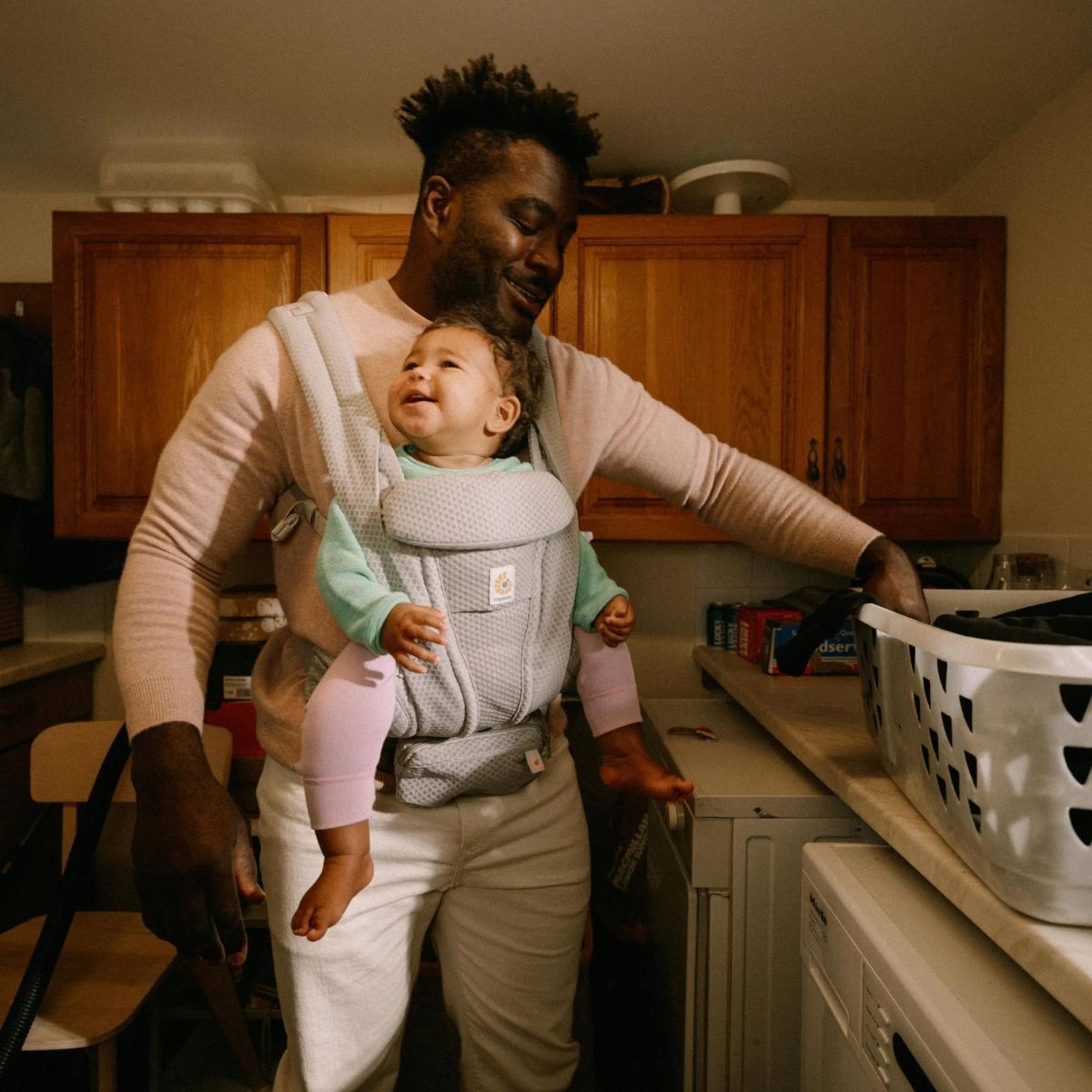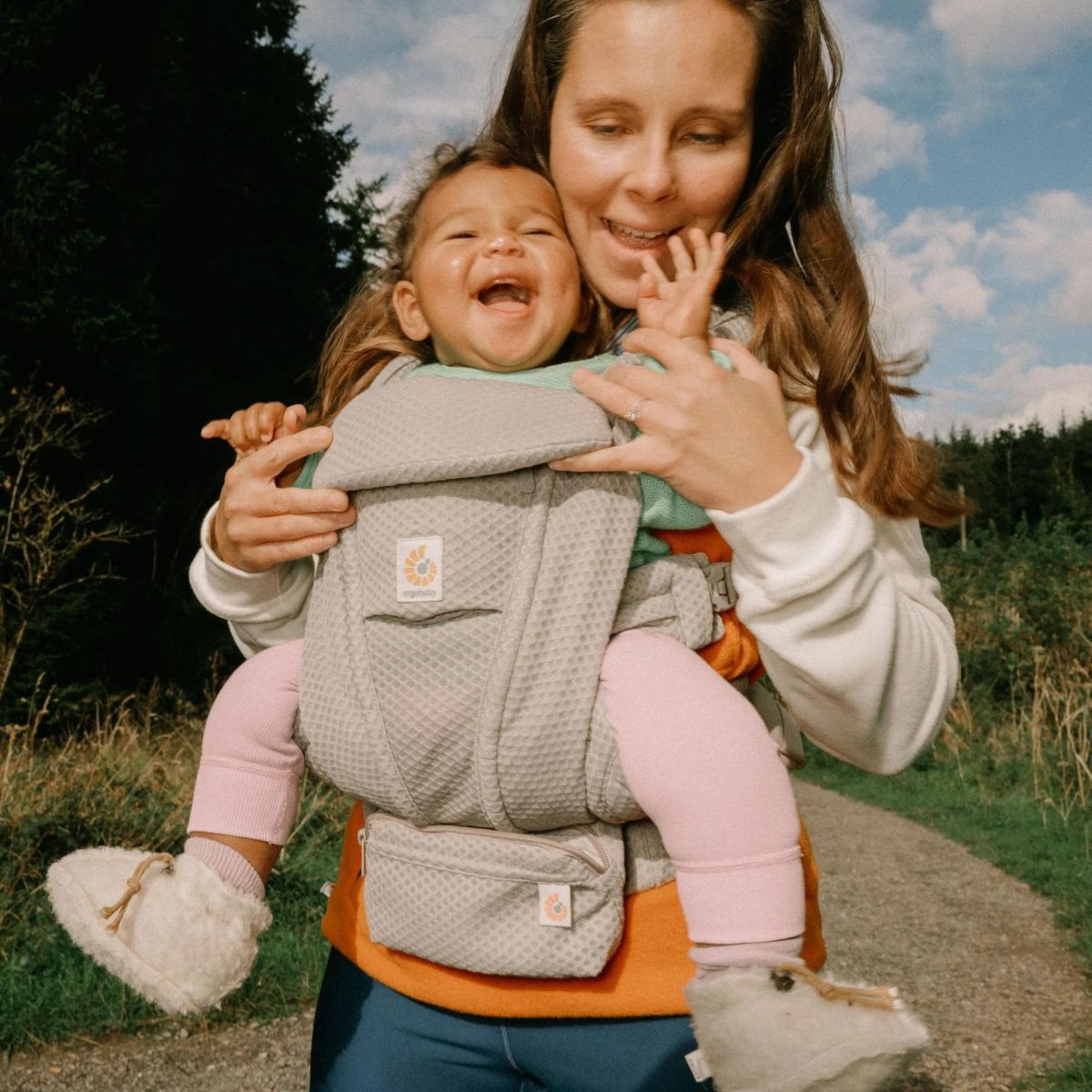Forward facing babywearing used to be a hot topic for debate, when there were no ergonomic baby carriers available, and the baby carriers let the baby’s legs dangle when carried. But not today with ergonomic designs like the Ergobaby Omni Deluxe, Embrace, and Aerloom carriers. Now you can safely carry your baby front facing while keeping them comfortable and supported.
Ergobaby baby carriers have been tested and certified by both the AGR (Aktion gesunder Rücken e.V.) campaign for healthier backs and the International Hip Dysplasia Institute offering you total peace of mind when it comes to ergonomic positioning in all carry positions.
Whether you’re searching for the best front facing baby carrier, wondering when can baby be front facing in a carrier, or just curious about safety, here’s everything you need to know.

How and when can baby be front facing in a carrier?
1. Baby’s Age & Size
Your baby should be at least 5–6 months old, weigh 6.4kg or more, and have their chin above the top edge of the carrier panel when seated deep in the seat of the baby carrier not on the waistbelt
2. Strong Head & Neck Control
Most babies develop this around 5–6 months, but every baby is different. They should be able to look around and turn their head comfortably back and forth with interest. They need to be able to do this before front facing in an infant carrier is an option
3. Awake & Alert
Front facing is best for curious, engaged babies. If they start to get sleepy, switch to inward facing to protect their airway
4. Choose the Right Environment
Start in quiet, familiar places to avoid overstimulation - think at home, backyard strolls, park walks, or running neighborhood errands
5. Check Baby’s Position Every Time
-
Perform a pelvic tuck so knees are above hips in a spread squat or M position every time you use an infant carrier front facing
-
Never let baby’s legs dangle
6. Adjust Your Ergobaby Carrier for Front Facing
-
Omni collection: Push sliders down/inward
-
Embrace: Bunch fabric between thighs
-
Aerloom: Pull front tabs tight to narrow panel
-
Aura Wrap: Not designed for forward facing
7. Start Small
Begin with 10–20 minutes at a time, increasing gradually. Watch for signs of fatigue and overstimulation in your child (crying, rubbing eyes, restlessness, head turning away, etc.) and then change to inward facing positions or take your baby out of the carrier.
8. Watch for Signs of Fatigue or Overstimulation
If baby turns their head away, rubs their eyes, or becomes fussy, switch back to inward facing
To keep them comfortable, start with short sessions in calm, familiar spaces and increase time gradually

FAQs About Forward Facing Babywearing
Q: When can my baby be front facing in a carrier?
Most babies are ready around 5–6 months, once they meet the size and head control milestones. They should be able to look around and turn their head comfortably from side to side before front facing in an infant carrier.
Q: Is a forward facing carrier bad for my baby?
Not with an ergonomic forward facing baby carrier like Ergobaby carriers. These carriers are certified by the International Hip Dysplasia Institute for supporting a healthy hip position:
-
Hips in the “M” or spread squat position: knees higher than bottom, thighs fully supported
-
Adjustable seat width to avoid hips being forced too wide or too narrow
-
Even weight distribution to reduce strain
-
Thigh support to prevent dangling legs
Q: How long can my baby stay in the forward facing position?
Start with 10–20 minutes in low-stimulus environments. Increase gradually while watching for signs of fatigue or overstimulation
Q: How do I use my Ergobaby carrier for forward facing?
Adjustments vary by model:
-
Omni: Push sliders down/inward
-
Embrace: Bunch fabric between thighs
-
Aerloom: Pull front tabs tight to narrow panel
-
Aura Wrap: Not designed for forward facing
Q:How to Why Forward Facing Can Overstimulate a Baby?
Forward facing puts your baby in full sensory mode: seeing, hearing, and feeling everything at once. Unlike inward facing, where they can snuggle into you for comfort, forward facing means:
-
More visual input – constant movement, colors, and changing scenery
-
Increased noise – street sounds, chatter, or sudden loud noises
-
No built-in “pause” – they can’t easily turn into you to rest
-
Extra physical effort – holding their head up and engaging their body
Ready to give your baby the best view in the house?
Enjoy ergonomic comfort, safety and style with ALL Ergobaby baby carriers. Don't forget Ergobaby carriers are guaranteed with the ErgoPromise™



















Forward Facing Babywearing: When, How and Tips for Using a Front Facing Baby Carrier